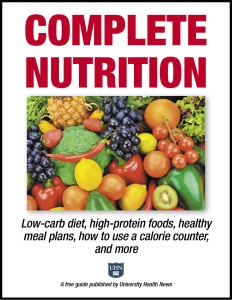Angina Pain Feels Like Pressure on Your Chest
Angina is chest pain that is not in itself an illness, but rather a symptom of a potentially serious condition. The most common form is “angina pectoris,” which is chest pain that occurs when your heart doesn’t get the nutrients it needs to function properly. The American Heart Association (AHA) describes angina as “pressure or squeezing in your chest. The discomfort also can occur in your shoulders, arms, neck, jaw, or back. Angina pain may even feel like indigestion.”
With angina, you may also experience:
- Anxiety
- Dizziness
- Nausea
- Shortness of breath
- Sweating
- Weakness
Although men usually don’t have a stabbing pain with angina, women may.
Eat Right, Starting Now!
Download this expert FREE guide, Complete Nutrition: Low-carb diet, high-protein foods, healthy meal plans, how to use a calorie counter, and more.
Create healthy meal plans and discover the Superfoods that can transform your plate into a passport to better health.
Anything that stresses your body can bring on angina, but the most common triggers are:
- Cold temperatures
- Exercise
- Emotional stress
- Large meals
Angina can worsen without addressing the source of the pain—the more stressed you are, the harder your heart beats, and the more pain you feel. Once the stress you’re dealing with is eliminated—and your body is at rest—the angina usually subsides. “Exercise, anxiety, or fighting with your in-laws all are examples of things that increase your blood pressure and heart rate, thus increasing the demand for oxygen and nutrient-rich blood to feed the heart muscle and meet the demand,” explains Secondscount.org. So, if your family got on your nerves over the recent holiday and you experienced angina that went away when they did, you would be wise to mention this to your doctor. Your heart is physically reacting to stress, and there’s a reason for it.
According to the U.S. National Library of Medicine (Medline), angina can also be caused by illnesses, including:
- Anemia
- Coronary artery spasm
- Heart failure
- Heart valve disease
- Irregular heart rhythms
- Overactive thyroid
Stable vs. Unstable Angina
The good news is that angina that arrives with a known stress trigger and leaves when that trigger is removed is the mildest form of angina. This is called “stable angina” because it’s predictable. You usually know the cause, and the pain lasts a few minutes to up to 15 minutes. It subsides when you stop and rest. It’s still a warning you should not ignore, however, because angina is never normal.
However, if you experience angina when you are already at rest and/or for no apparent reason, with pain that comes on suddenly (as opposed to building as your heart works harder), you may have unstable angina. Unstable angina is a heads up that a heart attack is in your near future. Get treatment now to avoid that heart attack. Heading it off will lessen the damage to your heart and improve your prognosis considerably.
Less common, but extremely painful, types of angina include variant/Prinzmetal angina and microvascular angina. Variant angina usually occurs between midnight and early morning. It can be very painful. It is caused by a spasm in the coronary arteries. The AHA estimates two out of 100 cases of angina are due to variant angina.
Microvascular angina can last longer than other forms of angina—up to 30 minutes, says the AHA—and is quite severe. Caused by a spasm within the walls of the smallest coronary arteries, microvascular angina is typically accompanied by sleep problems and a lack of overall energy. Most people notice it during daily activities and times of mental stress.
Angina Treatment
In order to treat your angina, your physician will need to find the cause. Among the most common diagnostic tests are:
- Blood work, including a lipid panel
- Cardiac CT scan
- ECG, or electrocardiogram
- Nuclear stress test
- Stress echocardiogram
- Stress test/exercise-tolerance test
Once information has been gathered from these tests, your physician will decide the best treatment. According to Medline, these options may include one or more of:
- Lifestyle changes, including diet and exercise
- Procedures, such as coronary angiography or angioplasty with stent placement, open heart surgery, heart-valve replacement
- Medicines, including:
- Anti-clotting medications, like clopidogrel and/or baby aspirin
- Beta-blockers, which lower heart rate and blood pressure
- ACE inhibitors, which lower blood pressures
- Calcium channel blockers, which relax arteries
- Nitrates, which help prevent angina
- Ranolazine, which treats chronic angina
You may also be given nitroglycerin pills or a spray to use in an emergency to stop chest pain.
The post Angina Pain Feels Like Pressure on Your Chest appeared first on University Health News.
Read Original Article: Angina Pain Feels Like Pressure on Your Chest »
Powered by WPeMatico


